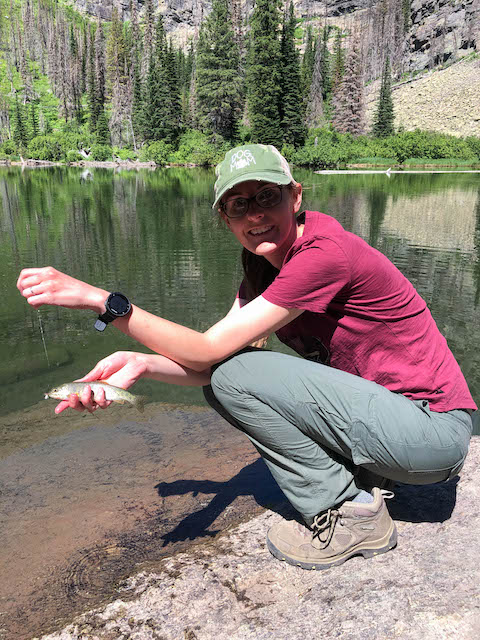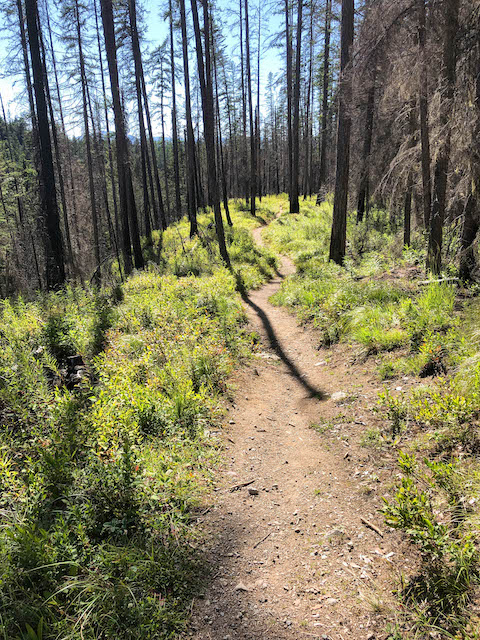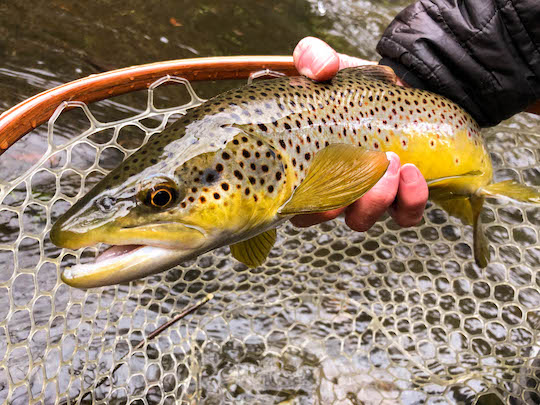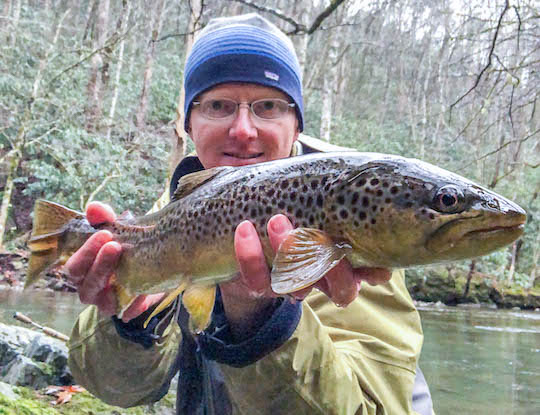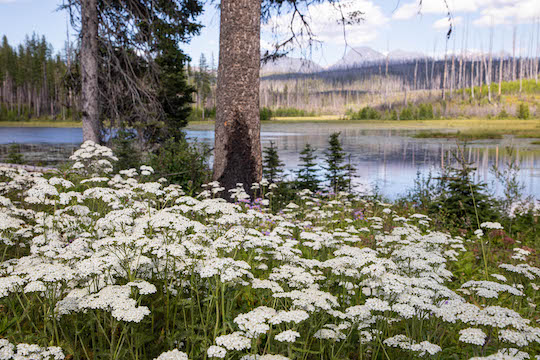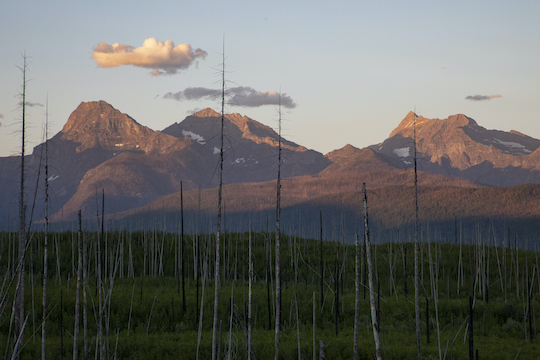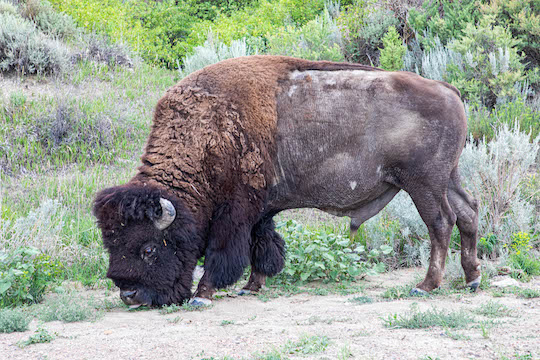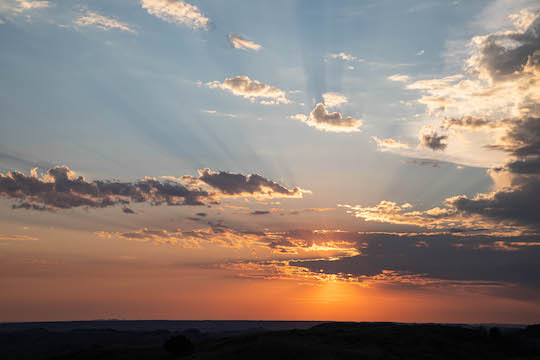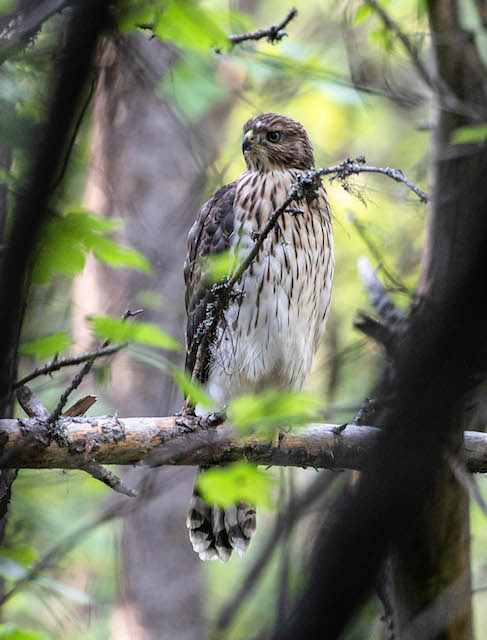Featured Photo: Fall Colors on Little River

Sunday, January 03, 2021
Glacier Day Two: Hiking and Fishing at Snyder Lake
Thursday, December 24, 2020
Great Smoky Mountain Brown Trout Extravaganza
Recently, I posted about fishing for post spawn Smoky Mountain brown trout. The first fish of the day was a good one, but as I alluded to in my previous post, this wasn't the end of the day. In fact, it was just the beginning of one of the best days of fishing I've ever had in the Smokies. As you know if you've followed this blog for any length of time, brown trout are right up there with my favorite fish to target, whether its on the fly or otherwise. I also have a real soft spot for brook trout, but in the winter, my thoughts turn to brown trout.
December through February has always been exceptionally kind to me when it comes to brown trout. I've caught my largest brown trout during those months and also had my largest Smoky Mountain brown trout caught in that time frame. The low sun angle means lower light, and I prefer to target cloudy days to further enhance that benefit. Rainy or snowy days are best, but are also an exercise in persistence and perseverance. Fishing in cold rain is not for everyone, and on some days I don't last very long, but the results are hard to argue with.
A few years back, my wife and I took a trip to Yellowstone National Park. Of course, fishing was a part of the trip along with hiking, photography, and general sight seeing. One thing I did in particular was to make time to fish with my friend Bryan Allison to learn some new techniques that would help me become a more well rounded angler and guide. Bryan is an excellent guide covering a variety of waters in Montana and offering some unique trip options that are difficult to find. You can visit his site here.
On our trip, I wanted specifically to work on some trout jigging techniques that he has mastered and are deadly on trout in a variety of waters. Fast forward to now, and you'll find me with a couple of very nice ultralight spinning rods loaded with 4 pound test that rarely if ever see any action. I bought them to be able to offer the option on guided trips, and occasionally mess around with them, but in general I prefer catching fish on a fly rod.
On my recent trip to the Smokies, after catching such a nice brown trout very early in the day on my fly rod, I decided to experiment with the things I had learned from Bryan. My day was already made with that quality brown, so it was time to practice some different techniques. One thing he had taught me was how to use marabou jigs. I figured that was as good of a thing to try as any, so I quickly tied one on and started working it carefully. One huge bonus of using the spinning rod is that you can mostly stay out of the water. That is probably the biggest reason that I try this method more in the winter than at any other time of the year. On really cold days, it keeps me up on the bank, and hopefully away from potential swimming events.
It wouldn't take very long to get things going with the marabou jig. Shortly after nailing my first fish on the fly rod, a golden flash blew up my jig and I was fighting another quality fish. And another, and another, and..........well, you get the idea. The fish were keyed in and ready to chase. Every once in a while the stars align and everything comes together for a great day of catching. Of course, every day is a great day of fishing, but the two aren't always synonymous with each other.
This was really an ideal day to streamer fish, because you want to hit it when the fish are fired up. However, with the falling temperatures and snow starting to fall, I just decided to stick with the trout jigging and stay out of the water as much as possible. The spinning rod was a good way to mostly keep my hands warmer as well. Since I wasn't handling the fly line every cast, I wasn't getting my hands as wet which translated to warmer hands. I still got them plenty wet often enough though. Some quick fish pictures seemed like a good idea to help me remember the epic day that was developing. One other benefit to staying out of the water is that you aren't endangering the redds with their precious cargo of brown trout eggs. Remember to avoid walking in sand and gravel areas in the tailouts of runs and pools. Fish often spawn in these areas and those eggs won't hatch for at least another month most likely.
After that first stop which produced three or four quality brown trout, I moved on up the river. In almost every spot I stopped I found fish. Interestingly, they were all falling into one of three size categories. I've been discussing the lack of truly large fish with my friends lately. Little River seems to be in between big fish cycles. As with most things in nature, numbers of giant brown trout seems to be rather cyclical. Right now, we appear to be on the downside of a cycle. I've seen good numbers of fish up to 18 inches or so, with a few fish pushing on to the 22-23 inch range, but some of the giants of past years don't seem as plentiful. Quite a few of my friends have noticed a similar trend.
On this particular day, I was catching a lot of fish in the 10-17 inch range. The big fish just seemed completely missing in action. When the fishing catching is this good, you normally expect to at least see a few larger trout. I decided to double down and really work some areas that historically hold large brown trout. Yet, it continued to be the same story. Plenty of fish, but no monsters.
I was working up one favorite run and had already caught some fish. In fact, I had some nice browns fighting over my offering at one point. It was just one of those days. Working on up past where I normally see the larger fish, I decided to work on up to the head. This time of year, the fish tend to stay farther back in pools, but it was worth a shot.
As I crept along, I spotted a brown laying on the bottom just upstream. I managed a decent cast and bounced the jig past the fish. Once, twice, three times, it was still as a statue. Suspecting that the fish already knew I was there, I threw one more cast well upstream and began a slow retrieve back past the fish. That was just too much. The fish bolted upstream and out of sight. At no more than a foot long, it wasn't a big fish, but I hate spooking fish ahead of me as they usually alert everything else to my presence. I almost gave up and turned around right there, but something drove me on.
Maneuvering carefully into position, I cast almost straight across. I got one good bounce with the rod tip and something heavy slammed the jig on the drop. Immediately worried about the 4 pound test line, I hoped my knots were good. The drag was set just loose enough while the flex of the ultralight rod absorbed the head shakes. Soon, I slid a gorgeous post spawn female brown into the waiting net. She just about filled up my big Brodin net and pushed the tape to right at 20 inches.
She was lean after the spawn and clearly needed some good meals before winter really set in. I was careful to keep her in the water except for a couple of seconds for a couple of quick pictures. The big net is really handy for these moments. You can rest the fish in the water in between shots, and not risk keeping them out of their element for more than 3-4 seconds at a time. Careful catch and release methods are essential to the preservation of these fisheries as fishing pressure continues to increase every year. If you can't accomplish this, then you should probably avoid fishing for these fish.
The good news about all of these fish is that they can also be caught on a fly rod if you don't want to use a spinning rod. In fact, much of the year, a fly rod is a better tool. However, if you are looking for a way to fish in the winter without getting too wet, then give trout jigging a try. Whether you are fishing in the Smokies or on the Clinch or Caney Fork, this technique works.
Tuesday, December 22, 2020
Glacier Day One: Lessons Learned, Going to the Sun Road, and Howe Lake Trail
After long days of driving, we finally were ready to explore Glacier National Park. However, we had some lessons still to learn before we could experience everything that Glacier has to offer. We got up reasonably early on our first morning in Glacier. We had stayed at Fish Creek Campground and had a very restful night of sleeping among the pines. It is always tricky reserving a campsite sight unseen, but this was a nice campground and we would definitely stay there again. Since we had one more night at Fish Creek, we were able to get up, enjoy breakfast, and hit the road without worrying about taking down our camping gear.
Of course, the first thing we wanted to experience was the Going to the Sun Road. There are very few roads in the United States that can rival this one for sheer beauty and scenic views. However, we would soon start running into trouble. Our plan was to hike some every day. However, as we began up the Going to the Sun Road, each trailhead was jam packed full of people. Cars were continuously circling like vultures, waiting for a parking space. After a couple of laps at the Logan Pass Visitor Center parking lot, we quickly decided to keep going on the main road and look for other options. Each parking area in turn had a similar problem, at least it did if it was anywhere close to a trailhead. With a list full of hikes we wanted to try, we realized that we would have to be a lot more proactive in starting hikes early.
Going into this trip, I had several good friends that advised me about conditions and hikes in Glacier. There were several common threads such as get a very early start to obtain parking and spend a lot of time at Many Glacier. With the east side of the Park shutdown due to COVID-19, that part of our itinerary was out so we had to start making adjustments. On this first day, with parking at a premium and not wanting to spend the whole day driving in search of parking, we vowed to not get caught searching for parking again. Instead of stressing about missing the hikes we wanted to do that first day, we decided to try something different.
Before going elsewhere, we did find a few pullouts with room for us to park and enjoyed taking our first daytime pictures of Glacier National Park. The rugged beauty was awe inspiring and we couldn't wait to trek through these beautiful mountains, but first things first. It was time to explore.
A small gravel road took off behind our campground. The Inside North Fork Road actually didn't connect all the way through to the Pole Bridge Entrance. While maps show this as a possibility, current park maps showed part of the road closed. I'm not sure if this is an ongoing thing or if it will be reopened soon. Based on the road we drove, I'm guessing part of the road is washed out or otherwise impassable.
We started down the dusty gravel road hoping to find wildlife or something else to enjoy. By the time we reached the end, we had seen a few birds, but nothing more. The bright sunny weather probably had the animals moving more nocturnally. We still had a lot of the day to spare and decided to take a hike we hadn't planned on doing. It turned out to be a great decision.
The Howe Lake Trail begins from a small parking area on the Inside North Fork Road a few miles north of Fish Creek Campground. The hike to the lake is just a couple of miles which made for a good warmup for what we hoped would be a big week of hiking. Little did we know how much hiking we would actually accomplish!
Howe Lake is really two lakes connected by a swampy channel. It looks like perfect moose habitat and we were really hoping to see one. It was not meant to be, but we did enjoy seeing a trumpeter swan and some ducks afar off. The wildflowers were beautiful on the ridges surrounding the lake while lily pads were producing a few beautiful blossoms on the lake itself.
Arguably the best thing about the Howe Lake trail was the solitude. On most of our future hikes in Glacier National Park, we would encounter an endless stream of other hikers and tourists. However, on this trail, we only encountered a couple of other groups of hikers. A word of caution should be mentioned here. Because this is a less travelled trail and you are in grizzly country, I would suggest a bit more care should be taken than usual. While grizzly precautions should be taken on all hikes in Glacier, the busier trails almost guarantee you won't be the first to surprise a bear. On this trail, it is a distinct possibility so plan accordingly. Carry your bear spray, be very familiar with how to use it, and most of all, make plenty of noise.
We found just enough mosquitos on this hike to make us glad that we weren't planning on spending the night. Little did we know how much worse the bugs would be on some of our other hikes. The mosquitos soon encouraged us to leave these tranquil lakes and we were quickly back at the car with a little over four miles of hiking accomplished on our first day in Glacier National Park.
That evening, after supper, we decided to head out the Camas Road to look for wildlife. We didn't accomplish our main goal, but the evening light on the mountains of Glacier was incredible. The moon setting over skeleton trees was eerily beautiful as well. We stayed busy with our cameras for a bit, but soon decided that we better get to bed. The next day was going to be a busy one as we had to move camp and also wanted to accomplish some hiking. That meant a very early start...
Saturday, December 19, 2020
Tying and Fishing David Knapp's PB&J Streamer [VIDEO]
The Motivation Behind the PB&J Streamer
The Design Process for the PB&J Streamer
Tying the PB&J Streamer
Fishing the PB&J Streamer
Variations on the PB&J Streamer
Thursday, December 17, 2020
First Night in Glacier National Park
Sunday, December 13, 2020
Post Spawn Smoky Mountain Brown Trout
The fall brown trout spawn has recently wrapped up for another year. Things seemed a bit later than usual, although there were fish spawning by the first or second week of November. This is a time of year to use extra care while wading and fishing. Spawning fish should be allowed to do their thing in peace. After the fact, it is essential that anglers avoid wading on the redds. Doing so will crush the eggs that were deposited there and severely impact the next generation. They already have enough challenges in reproducing.
After the spawn is over, the fish feed heavily as we move into the winter months. The fish are trying to regain body mass after the rigors of spawning. This can be some of the most exciting fishing of the year but also perhaps some of the most miserable. That is because the weather often leaves a lot to be desired.
Last week, I had a free day and decided to go fishing for myself. The day started out perfectly and just got better from there. The sky was threatening snow, and snow days have been some incredible producers for me in the past. The temperature started in the low 40s and fell throughout the day.
The first caught fish of the day was one I spotted on my second or third stop. I was looking as much as fishing at this point. However, when I noticed a hefty brown trout holding near the back of a quality run, I couldn't resist fishing.
I had been walking and looking without a rod. This is a sure way to guarantee that you actually spend time looking, not fishing. After spotting the fish, I took the time to walk back to the car and rig up appropriately. A big black wooly bugger seemed like the right idea, and I added a worm as a dropper. Winter fish really like both of those flies for whatever reason.
Back on the water, I took a minute to find my fish again. Sure enough, it was still hanging out in the same general area. I noticed that it ate something drifting by and started to feel the excitement surge. This was a feeding fish and feeding fish are catchable fish. Clambering down the bank took some doing. I dealt with a bum ankle for part of November and wasn't interested in aggravating the high ankle sprain again. Thankfully, each step on the slick leaves held, and I was soon standing on the stream bank. Sneaking upstream along the bank, I reached the point where I would begin my stalk.
The fish was sitting in a nearly perfect spot, not too far above a large mid stream boulder. Cover like this can make or break a stalk of a big brown. In my case, the fish never knew I was coming because of the ability to sneak in behind the rock. Once I arrived in position, it was time to actually execute. This is NOT the moment to rush. Do everything right, and you catch the fish. It is that simple most of the time. Rushing is probably the quickest way I know to blow a good fish. I've done it many times in fact...
My leader was quite long, enabling me to keep the fish from seeing the fly line. I was using a 10' 3 weight Orvis Recon. The extra reach was going to be critical to keeping the leader and line from getting pulled through the riffle below the run before the fish had time to find the flies. Working out the leader and then some line, I false cast a couple of times to judge the distance. Then I slung all the flies in the riffle below me. I like to water load these casts. It helps to guarantee where the flies are going on the presentation cast.
Taking a deep breath, I knew that it was time. I quickly made a casting stroke under some low hanging branches and the flies landed a few feet upstream of the fish. My flies were perfectly visible in the clear water. I watched as the brown trout slid to his left and ate the wooly bugger. With just a slight hesitation to let him close his mouth, I gave a strong hookset and couldn't believe when the fly stuck. Some days you just get lucky. I'm always leery of first cast fish, but if they are this quality, then I'm glad to get skunked the rest of the day. On this day, however, things would only get better...
The fight was relatively quick. The flex in the 10' rod allowed me to push the fish hard on the 4x tippet. In what seemed like no time, I had the fish in the net and ready for a couple of pictures. The main reason I carry a large net is to keep fish healthy in between pictures, and I wasn't taking chances with such a gorgeous brown trout. Just a quick lift and snap, and I had the memory.
While I didn't know it at the time, this would be the first of many fine brown trout on the day. More about that next time... In that moment, though, I just sat down on the bank and took it all in. Big brown trout are always a treat and this one was a beauty.
Friday, December 04, 2020
Nature Awareness: Bird Language and a Cooper's Hawk in Glacier National Park
Wednesday, October 28, 2020
Stealth Mode: Light and Shadows
The original idea of "Stealth Mode" was created for an article I did in the Little River Journal quite a few years ago. Yesterday, while on a guide trip, something happened that is quite common, yet it struck me in a special way. It reminded me of the original premise of Stealth Mode and so I decided to expand on that original idea.
There are a multitude of opinions and ideas about the importance of stealth in fly fishing. Probably more accurately, I should say there are lots of opinions and ideas about the importance of different elements of stealth, such as whether clothing color matters. Thus, for this article, I'm going to mention up front that I'm writing mostly from the perspective of fly fishing in the Smokies. Furthermore, I'm quite interested in differing opinions or ideas because I can always learn more, so please leave a comment if you have similar or other ideas on the subject!
The moment that motivated this particular "Light and Shadows" version of Stealth Mode happened when my client and I were faced with a choice: cross the creek where I normally do, or continue working up the bank we were already on. I had already mentioned to him that we should cross when I looked upstream and noticed the distinct difference. The far (east) bank was lit up by the late afternoon sun slanting in from the southwest. The near (west) bank was shaded by the overhanging trees and rhododendron. Plenty of light was coming through increasingly bare branches, but there was definitely a LOT more light on the other bank. If we moved up that side of the creek, we would practically be glowing. Not a good way to approach fish if you ask me!
So, I mentioned our options to him, and we decided to stay on the near side of the stream. Turns out it was a good decision as we caught a fish shortly just upstream. If we had been on the other bank, I'm not so certain that a caught fish would have been the result. In fact, based on all the fish that I had seen spooking out ahead of us in the seasonally low water of fall, I doubt we would have caught any fish in that pool.
I should take a minute to add a caveat. This advice applies more than anything to flatter water such as the long pool we were approaching when this moment happened. In broken pocket water, you can often get much closer to the fish, especially as long as you stay relatively low. The fast water helps hide your approach. That said, we continued on up around the bend on the shady side of the stream, and I think it helped us out. The difference between the two banks was at times striking and at other times less obvious, but staying in the shadows is generally a good idea in the Smokies.
In addition to considering which side is sunny or shady, you should also consider your own shadow. As we moved upstream, the late day sun was slanting across the river from our left. At times, our shadows were falling across the stream in the direction we wanted to fish. Sending a big dark shadow over a pool is as good a way to spook fish as anything I know. Instead, fish from further back. In fact, it would probably be better to cross over and fish from the sunny bank instead of casting a shadow across the pool.
So, next time you are out fly fishing, consider being stealthy as more than just sneaking up behind boulders and crawling on the ground to approach a fish. Consider the light and how you interact with it. That consideration could make or break your fishing trip.
Sunday, October 25, 2020
How To Select the Perfect Fly Rod
As a fly fishing guide, I am asked about the perfect fly rod a lot. People have a variety of questions, but they all boil down to this: what is the best fly rod? These questions can be in the form of a beginner asking what the best fly rod for a beginner is, or they can be asked by intermediate anglers looking to upgrade. For example, "I've been fly fishing for a while and I'm ready for a better/nicer/more awesome/(fill in the blank here) rod. What fly rod should I buy?" Before I get into attempting to answer what is always a loaded question, I want to clearly state that this is an extremely subjective question. However, I'll try to give a reasonable answer based on what type of fishing you are looking to do.
What I'm NOT here to do is to sell a certain brand or type of fly rod. There are lots of good makers out there, and probably the best advice I can give anyone is to go into your local fly shop and cast a bunch of rods. Do this even if you aren't experienced. The shop staff will probably even give you a free casting lesson if you need it. Wherever you are on your fly fishing journey, one rod will probably speak to you more than the others. Chances are good that it won't be that $900 high end model, but if it is and you can afford it, go for it. There are plenty of good rods being made these days that won't break the bank, so make sure the fly shop staff know your budget before they start lining up some rods.
First, you need to consider what kind of fishing you plan to do. If you don't know the answer to this, then find your local fly shop or a local guide and take a lesson or guided trip to see if this is even for you. However, chances are that you have already done some research and figured out that you want to fly fish for trout or bass and panfish or maybe even saltwater. Whatever you plan to do will affect your rod choice. I'll tailor this explanation to middle and east Tennessee, but the principles will apply to wherever you want to go.
Here in Tennessee, people fly fish for trout, largemouth and smallmouth bass, panfish, musky, stripers, carp, and a few other random species. For fishing on moving water, your options will range from small headwater streams like we find for trout in the Great Smoky Mountains National Park, to large tailwater rivers like the Clinch River, Holston River, and Caney Fork River. These large rivers contain trout, bass, and other species.
For fly fishing in the Great Smoky Mountains, streams range from tiny brook trout water choked with rhododendron, to good sized low elevation trout rivers that also contain a few smallmouth bass. For smaller headwater streams, your best rod choice will be in the two through four weight range and be between 7' 6" to 9' long. You can fish most streams with longer rods. Only the very smallest, tightest brook trout streams fish best with anything less than 7' 6". On those smaller streams, I actually tend to go heavier on the rod while also going shorter. A four weight will roll cast and bow and arrow cast into tight places better than lighter lined rods will. These streams are mostly hard to access and are not for most anglers due to the work required in fishing them. The average Smoky Mountain stream will fish best with a rod in the three to five weight range and range from 8' to 10'+. In my opinion, the best all around rod for most fly fishing in the Smokies is a 10' three weight rod. This rod works fine for most brook trout streams and excels in the low to mid elevation streams that feature large pocket water stretches. This advice applies to any higher gradient pocket water stream from the eastern US to the Rockies and beyond.
This seems like a good time to address a common misconception about fly rods for the mountains. There are a lot of people who think you need a shorter rod to stay out of the trees. While there are certainly some streams where that applies, the vast majority of mountain trout fishing is easier with a longer rod. If you want to hit the sweet spot and get one rod that is a good compromise, then go with an 8' or 8' 6" rod. That said, there are many places on larger streams where a longer rod will help.
With practice and experience, that longer rod will rarely be a liability. More often than not, the extra reach will help you get to fish that you otherwise would have missed. This is almost always true when you are high sticking. On larger pools where you have room to cast, the longer rod is also helpful for better roll casting although not mandatory. It also helps to make mending easier since you can pick up more line prior to each mend. The shorter you go on your fly rod, the better your line management skills better be. Things like mending, a reach cast, and other line management tricks come into greater focus with shorter rods. A longer rod is a tool that will make even below average anglers look good.
One other thing about a good fly rod to consider is the action. For fly fishing in the mountains, if you are getting a rod primarily for nymph fishing, get something that is on the faster end of the spectrum. The ability to quickly set the hook is essential, and a fast rod will help make this happen. For dry or dry/dropper fishing, you can fish something slower if you like. My all time favorite Smokies rod for small to medium sized water is a very slow rod that makes dry fly fishing a blast. That said, while the rod works okay for nymphing, it is probably not the best tool for the job. A good all around action for the Smokies would probably be medium fast or fast. Just remember, however, that personal preference goes a long ways towards making this decision. If you like a softer rod, go ahead and get one and learn to set the hook harder and faster.
As we move away from the mountains and to larger streams and rivers, we need a rod that can handle some larger fish. If you are fly fishing primarily for trout on larger streams and rivers, then you will want a rod somewhere between a four and a six weight and ranging from 8' 6" to 10'+. Probably one of the best rods out there right now for this is a 10' four or five weight rod. The extra reach of the 10' rod makes mending a breeze and you can seriously air out some line with that long rod also. The longer rods are perfect nymph fishing but also handle dry fly rigs with ease. A standard 9' five weight will be a good all around rod for most situations on the tailwaters. If you want a compromise that will also do well for some streamer fishing and light bass, then go with the six weight. The six weight would also be a good choice if you plan on traveling a lot to fly fish out west. Anytime the wind starts to blow, a heavier rod is helpful.
As far as action goes, I would recommend staying away from super fast rods for this application. They cast line a mile, which is nice of course, but can be tough to get a hook set with the 6x tippets that are usually required on our tailwaters. A rod with a slightly softer tip (medium fast action) will help protect that fine tippet much better than the ultra fast cannons many rod manufacturers are making these days. If you plan on fishing mostly out west, then you can disregard this advice and go for the faster rod. Again, this is for the wind that one would expect out there.
Moving into fly fishing for smallmouth and largemouth bass, we need a rod that can handle larger fish and especially larger flies. I routinely use a rod in the four to six weight range for wading smaller streamers for smallmouth, but once I'm in the boat on a larger smallmouth river, I want a minimum of a six weight rod and more often will be throwing a seven weight. Don't be afraid to go even heavier. Anything in the 8' 6" to 9' range is fine for this task. Personally, I prefer a faster rod when I'm throwing big wind resistant bugs. The ability to power through wind and cast farther in general means a fast or at least medium fast action is required for this type of fishing. A good 9' seven weight rod is also an excellent streamer rod for trout when you are fishing high water out of a drift boat. My seven weight rods have the option of floating or sinking or sink tip lines depending on the fishing I'm doing that day. I've caught everything from trout to bass to stripers to musky on a seven weight and have also used it in the saltwater when chasing snook and other species.
Speaking of stripers and musky, these apex predator species are probably the largest fish most people will ever catch in Tennessee on a fly rod. Overall, fast action rods in the eight to ten weight range are ideal for these species. You'll be throwing large, wind resistant flies most of the time. Be prepared to have a sore arm by the end of the day when chasing these critters with heavy rods. While the rod is important, a quality reel is probably even more important for the stripers in particularly. Make sure you have a quality reel with a smooth and strong drag. The stripers will generally show you your backing very quickly on the first run. For musky, not so much.
With these larger rods and reels, I recommend getting a setup that can handle saltwater because at some point, you're going to want to try that out. A good eight or nine weight striper and musky rod can also make a good rod for redfish, snook, and even smaller tarpon. This same advice also goes with the six and seven weight rods if possible. The more versatile your equipment, the more enjoyment it can bring you over the years.
Speaking of tarpon and other saltwater species, I'm going to leave selecting a good saltwater fly rod for another day. There is a lot that goes in to the selection of a good fly rod, and I'll stick with common fresh water fly fishing for this article.
About that 9' five weight... If you have done much research at all, you've probably found the advice that a 9' five weight is a good all around rod for trout fishing, and it is. For most of our fishing here in Tennessee, that rod will do great for you. However, I would suggest that a slightly lighter rod will probably be even more enjoyable for fly fishing in the Smokies. Thus, we are back at my advice that you decide what type of fly fishing you primarily intend to do. If it is the Smokies, then look in the three to four weight range and get a rod that in the 8' to 10' range. Go towards the shorter end if you intend to do a lot of brook trout fishing and the longer end if you plan to spend more time on larger streams. If you are just planning to fish the Clinch River or Caney Fork River, then a 9' five weight is a great all around rod.
Willing to buy more than one rod? A great piece of advice I read many years ago was to get a rod for every other line weight. In other words, if you already have a five weight, your next rods will be a three and a seven weight. This gives you some excellent versatility. Make sure and get spare spools for the reels on your heavier rods. You'll want to be able to switch between floating and sinking presentations with those heavier rods at minimum. If you plan on doing a lot of still water fishing, then this advice also applies to lighter rods as well where sinking or intermediate lines will be used a lot. I generally get spare spools for all my reels. I can use the same reel for my two, three, or four weight rods. I just change out the spool to the one with the correct line.
If you aren't sure where to start shopping for a fly rod, check with your local fly shop if possible. Build a relationship with the local shop and you'll get great advice and help along the way for many years. My local shop that I spend a lot of time in is Little River Outfitters, but there are some other excellent shops in our area. Still not sure what rod you need? Let me know what you are wanting out of a rod in the comments and we can discuss what will work best for you.
Sunday, May 31, 2020
Fishing Report and Synopsis: May 31, 2020
I have spent most of my time on the tailwaters this month, especially the Caney Fork. It has fished very well and of course the fishing in the Smokies has been good also. Unfortunately, I have good and bad news on both fronts.
In the Smokies, the light colored bugs of late spring and summer are here and have been for a while. The sulfur hatch was particularly strong this year and now the little yellow stoneflies are out in force. That means good fishing for the near term at least. Good water levels continue to be the story as it is raining more often than not this year. Hopefully we'll continue to stay wet, at least up in the mountains, and fishing will remain strong right through the warm summer months. Expect the yellow bugs to continue. Some larger golden stoneflies should be around and offer the larger fish some big bites. Don't forget terrestrials now as we transition into summer. Green weenies, beetles, and ants are all important at times in the mountains. The one small sliver of bad news? Crowds are as bad as I've ever seen them in the Smokies. The National Park Service is keeping the Elkmont area closed for some reason with the official reasoning having to do with COVID-19. That means a longer walk if you want to fish upper Little River. Otherwise, most of the Park is open and accessible now.
The Caney Fork was fishing great the last few weeks. It looked like we were on target for a good to excellent year of fishing there. Unfortunately, the Corps of Engineers slammed the brakes on that at least temporarily by conducting spill operations on the Caney this weekend. Why in the world you would dump warm lake water into a cold water fishery is beyond me. In fact, on Saturday, the generator was even shut off for about an hour, meaning the ONLY flow was warm lake water. After all the river has been through, I can't believe that they decided the best idea was warm water. We can only hope that the fish hunkered down and made it through. As long as the generator is on, there might still be enough cool water to not kill all the trout. Unfortunately, this surge in water temperatures is going to draw all the stripers up into the river now. That will probably mean the end of good spring fishing on the Caney about a week or two earlier than normal. If the trout make it through the spill operations the past couple of days, then we might have some decent fishing a bit longer, but things are probably on the annual downward spiral now. I just hope I'm wrong about that. The one silver lining this year is that the dam is being operated on a normal schedule, meaning there is more cold water storage available for summer and fall. Hopefully there will be some trout left to take advantage of that.
Smallmouth streams have been often running too high for good wade fishing like I enjoy. Over the next 1-3 weeks, that should change and with the heat of summer will come good smallmouth fishing here on the Cumberland Plateau.
















